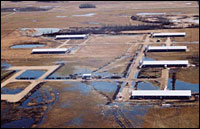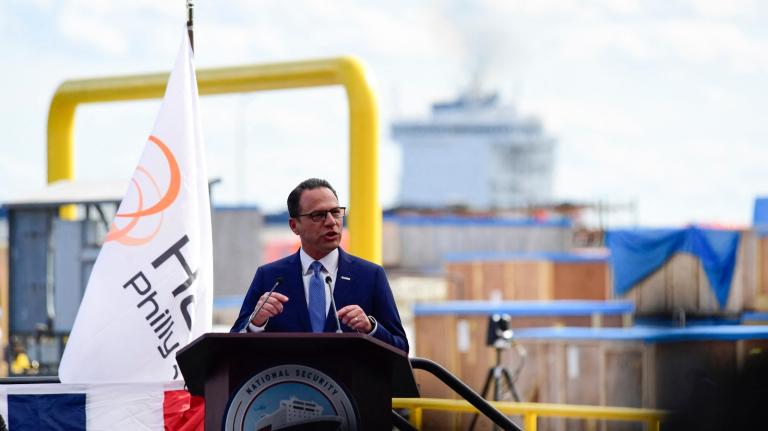The Bush administration wants to let factory farms determine whether the animal excreta that oozes from their facilities into waterways should be regulated, environmentalists say — and they argue that the plan, well, stinks.

The cow factor.
Photo: iStockphoto.
Agriculture has long been a top source of water pollution in the U.S., but in the last two decades the scale of the problem has grown dramatically with the proliferation of large-scale pork, poultry, beef, and dairy facilities, known as concentrated animal feeding operations (CAFOs). From 2002 to 2005, the CAFO industry in the U.S. expanded by about 22 percent — with substantially more animals per facility, and ever-larger piles of their droppings.
Today these facilities are responsible for some 500 million tons of animal manure a year — three times more waste than humans in this country produce, activists say. According to a 1998 report from the Department of Agriculture and U.S. EPA, CAFO muck has fouled roughly 35,000 miles of rivers in 22 states and groundwater in 17 states. More recent data show that 29 states have reported water contamination from these feedlots.
Last week, the EPA proposed a rule [PDF] that purports to address this problem. It would revise a set of rules issued in 2003 that revamped the permitting process required of CAFOs under the Clean Water Act, with the aim of better tracking discharge levels at each facility and holding factory farms accountable for their water pollution.
The 2003 rules were deemed inadequate by the 2nd U.S. Circuit Court of Appeals last year. This decision was the upshot of a lawsuit filed by the Natural Resources Defense Council, the Sierra Club, and the Waterkeeper Alliance alleging that U.S. waterways aren’t sufficiently protected from farm-animal feces, which can carry viruses, parasites, and bacteria such as E. coli.
Says EPA spokesperson Dale Kemery, “The new rule complies with the 2nd Circuit decision, and will result in better Clean Water Act compliance among CAFOs.”
But enviros disagree. “The court required the EPA to bring clarity to some aspects of the 2003 rules; instead they’ve created more confusion and new loopholes,” says Michele Merkel, a former staff attorney in the EPA’s enforcement division who now works for the nonprofit Environmental Integrity Project. The most concerning loophole, she says, would allow CAFOs themselves to define what constitutes a polluting discharge, and therefore decide whether a permit is needed at all.
Such flexibility flies in the face of the Clean Water Act, says Merkel, because the law prohibits all large-scale feedlots from discharging any traceable animal waste into nearby waterways, and requires them to obtain permits that offer exemptions under certain circumstances, such as when there’s runoff after a storm.
“The loophole basically renders the Clean Water Act meaningless when it comes to regulating the fecal discharge from CAFOs,” says Merkel. “It says to these massive facilities, ‘Hey, figure out if you need a permit to pollute, and then come and get one.’ It’s appalling.”
The agriculture industry, meanwhile, is applauding the proposed rule. Don Parish, senior director of regulatory relations for the American Farm Bureau Federation, says it would lighten the regulatory burden on CAFOs. Obtaining permits, he says, is “an onerous process. When you have a permit, every ‘i’ that you don’t dot and every ‘t’ you don’t cross is a problem, and creates substantial liability concerns.”

CAFO lagoon overflow.
Photo: FactoryFarm.org
Hogwatch
There are plenty of means by which CAFO animal waste can make its way into waterways, according to Melanie Shepherdson, a staff attorney with the Natural Resources Defense Council’s water and oceans program. The massive reservoirs in which the waste is stored, known as “lagoons,” are vulnerable to routine leaks or occasionally significant breaks in their walls. Also, since the lagoons are commonly uncovered, nitrogen from the urine and excrement gasifies into the air, then redeposits onto the ground or nearby water bodies and can run off into further rivers and groundwater supplies. And the waste is commonly liquefied and sprayed onto a CAFO’s surrounding fields, where it can likewise run off or leech into water sources.
“In 2003, EPA’s position was that if you’re a large-scale facility, it’s nearly impossible not to have some amount of discharge,” says Merkel. “Therefore all large facilities should have permits.”
And yet today the vast majority of factory farms still don’t have permits for this runaway pollution: Of the roughly 18,800 CAFOs currently in the United States, the EPA says only about 8,500 have permits.
Parish says this is just fine, arguing that the permitting process should not be mandatory for all CAFOs: “If you choose not to drive a car, does the government require you to have a driver’s license? No. Likewise, if CAFOs do not discharge or intend to discharge, they shouldn’t have to have a federal permit.”
The EPA adds that factory farms that send pollution into waterways without a permit risk punishment: “Under the Clean Water Act, CAFOs that do not seek permit coverage risk liability for any unpermitted discharges that may occur at the facility,” says Kemery.
But there are troublingly few penalties being doled out, or even inspections taking place, says Merkel. Between 1997 and 2004, the U.S. Department of Justice waged a grand total of eight lawsuits against CAFOs for violating water-pollution standards under the Clean Water Act.
“Without permits, government officials don’t even know you’re out there in many cases,” says Merkel. Take the example of Illinois, she says, a major farm state where nearly 85 percent of the total public lake acreage is contaminated. “There are at least 500 large CAFOs in the state; only about 40 have permits, and only about a fifth of them have even been inspected,” says Merkel. The state EPA has an inventory of only 30 percent of the CAFOs now operating in Illinois. “They don’t even know where the vast majority are,” says Merkel.
Says Shepherdson, “You’d be hard-pressed to find any other industry that is as loosely regulated as this one.” She says it’s no coincidence, noting that the ag industry is well-known for flexing its political muscle: “All of the big players have their trade groups out there on their behalf, lobbying both the EPA and friendly members of Congress to rewrite the [discharge] rules and exempt them from Clean Water Act requirements. The EPA is clearly kowtowing to industry and abdicating its role as protector of public health.”
The new rule is expected to appear on the federal register by July 3, at which point it will be subject to a 45-day public comment period. NRDC, the Sierra Club, and the Waterkeeper Alliance plan to submit detailed criticisms of the proposal, and Sierra Club attorney Ed Hopkins says they will consider a second lawsuit if their concerns are not taken into account.

